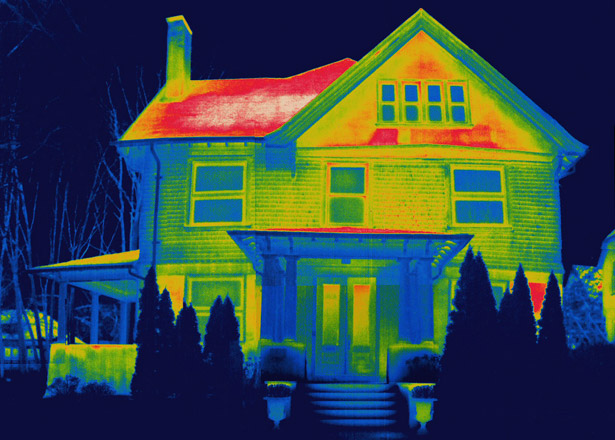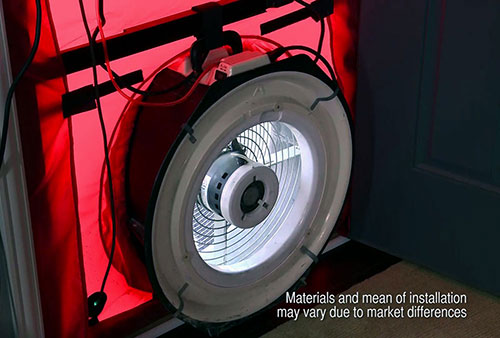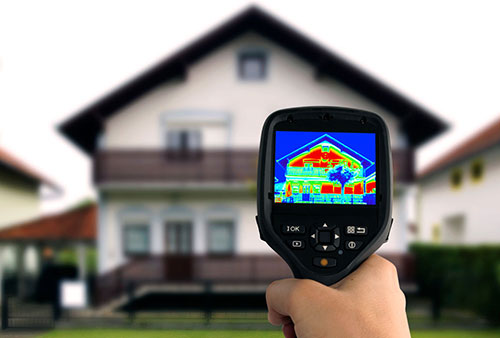Home Energy Assessments
Are you constantly adjusting your thermostat? Do have high heating and cooling costs? Do you have uneven, drafty rooms? Let Reichel help assess the energy-loss trouble zones in your home. Here are some strategies we use to perform home energy assessments.

HOME AIR TIGHTNESS TEST/BLOWER DOOR TESTING
A Blower Door Test is a powerful fan that mounts to the frame of an exterior door (typically your front door) which when run pulls air out of the interior of the home so that the higher outside air pressure flows in from all of the unsealed cracks and openings. A powerful fan that is mounted into the frame of an exterior door. The fan pulls air out of the house, lowering the air pressure inside. The higher, outside air pressure then flows in through all openings and unsealed cracks in the home.
How to Prepare for A Blower Door Test

- If you heat with wood, be sure all fires are completely out, not even coals, before the auditor arrives. Remove any ashes from open fireplaces.
- Plan to do a walk-through of your home with the auditor. Be prepared to point out areas that you know are drafty or difficult to condition comfortably.
- Expect the auditor to request access to all areas of your home including closets, built-in cabinets, attics, crawl spaces, and any unused rooms.
- The auditor will need to close all exterior doors and windows, open all interior doors, and close any fireplace dampers, doors, and woodstove air inlets.
- Expect the auditor to set controls on all atmospheric fossil fuel appliances to ensure that they do not fire during the test.
- Expect the test to take up to an hour or more, depending on the complexity of your home.
THERMAL CAMERA IMAGING

Thermal imaging for air tightness and energy efficiency are important quality control measures when building or renovating a home. Heat loss can account for up to 50% of total energy consumption in a building with causes like air leakage through chimneys, attics, and wall vents, badly sealed doorways, failing argon gas windows, and missing insulation.
Instead of opening your walls or ceilings for inspection, a trained specialist can use one of these infrared cameras to locate insulation voids, air leaks, moisture intrusion, thermal bypasses, and thermal bridges. Thermal imaging cameras are well-established as valuable inspection tools that help reveal missing insulation, HVAC air flow and equipment issues, radiant heating malfunctions, compromised roofing, and much more. By detecting and locating patterns and sources of heat loss that are invisible to the naked eye, thermal images provide convincing evidence in reports where improvements need to be made and how well they were completed.
THINGS TO CONSIDER DURING YOUR HOME ENERGY ASSESSMENT
It is important to take a whole-house approach to finding ways to conserve energy in your home. Upgrades such as replacing a refrigerator or installing a programmable thermostat can be done on your own, provided you know they are significant sources of energy loss. Here are some issues you can speak to a knowledgeable home energy auditor about.
- Air Sealing: Using the reading from the blower door, an auditor can figure out just how much air is moving through that gap at any given time. This is usually the biggest source of energy loss in a home, and sealing those gaps is one of the quickest ways to make your home more comfortable and efficient.
- Reset Water Heater Thermostat: Most water heaters heat water to a set temperature and then hold it there. This means that all day and night, the water heater cycles on and off, just maintaining that set temperature. Lowering the setting a few degrees can often save half as much energy as air sealing would. And chances are turning down the temperature won’t even be noticeable.
- Programmable Thermostat for Heating System: Just like the water heater maintains a set temperature even when it isn’t being used, a thermostat does the same thing for the entire house. Just letting it cool off (or warm up) when there isn’t anyone awake can save energy and money as well.
- Attic and Wall Insulation: The greater the difference between the indoor and the outdoor temperatures, the more energy it will take to maintain a comfortable temperature in your home. Adding insulation between the indoors and the outdoors reduces that energy demand.
- Replace Refrigerator: Much like a water heater, a refrigerator holds a set temperature that is very different from the air outside of it. It makes sense that a better sealed, better insulated refrigerator with better mechanical systems would save more energy. Depending on your previous model, a new ENERGY STAR refrigerator can save up to $150 per year. One way to test the seal on your refrigerator is to close a dollar bill in the door. If the bill drops when you close the door, you may want to consider fixing the seal or getting a new one. Depending on the refrigerator and the savings, this can pay for itself in 10 years—well under the average lifespan of the appliance.
- Water Heaters and Furnaces: The savings from water heaters and furnaces depend a lot on where the house is and what the fuel is. Generally, natural gas is going to be much cheaper than electricity, provided it’s available. The newer high-efficiency gas furnaces will often be worth installing, even if the gas furnace in your home is relatively new. Depending on if you live in a cold climate or a warmer one, a new high efficiency furnace will rival or exceed air sealing for its potential savings. In warmer areas, a high efficiency heat pump may replace a gas furnace as the best choice for the home.